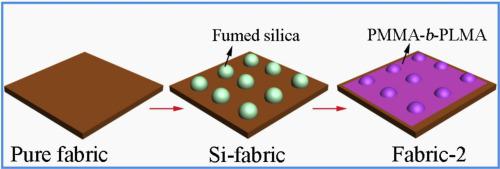当前位置:
X-MOL 学术
›
Prog. Org. Coat.
›
论文详情
Our official English website, www.x-mol.net, welcomes your
feedback! (Note: you will need to create a separate account there.)
Fabrication of fluorine-free superhydrophobic cotton fabric using fumed silica and diblock copolymer via mist modification
Progress in Organic Coatings ( IF 6.5 ) Pub Date : 2020-11-01 , DOI: 10.1016/j.porgcoat.2020.105884 Qingbo Xu , Lujie Wang , Feiya Fu , Xiangdong Liu
Progress in Organic Coatings ( IF 6.5 ) Pub Date : 2020-11-01 , DOI: 10.1016/j.porgcoat.2020.105884 Qingbo Xu , Lujie Wang , Feiya Fu , Xiangdong Liu

|
Abstract Immobilizing inorganic particles to improve the roughness or coating with fluorinated agents and polysiloxanes to reduce surface energy is the most popular approach for constructing superhydrophobic cotton fabrics. However, the poor durability, health and environmental concerns, and other serious drawbacks limit the application of superhydrophobic cotton fabrics. In the present work, we describe a simple and facile fabrication strategy to construct robust fluorine-free superhydrophobic surfaces of cotton fabric via a mist technique. The modified cotton fabrics were first immobilized by fumed silica (SiO2) particles to improve the roughness and then covered with a diblock copolymer of poly[(methyl methacrylate)-b-(lauryl methacrylate)] (PMMA-b-PLMA), which was synthesized by RAFT polymerization, to reduce the fabric’s surface energy. The mist technology used ensures that the PMMA-b-PLMA covers the SiO2 particles on the surface of the fabric with a thin coating. Therefore, the SiO2 particles were stably immobilized on the fabric surface without reducing the roughness. As a result, the water contact angle (WCA) values of the prepared cotton fabrics reached reached 156.7°±0.5°. Moreover, even after 1600 abrasion cycles or 80 laundering cycles, the WCA values of the fabric samples were still higher than 150.1°±0.5°. The stable superhydrophobic cotton fabric surfaces are useful for self-cleaning, oil-water separation, and other potential areas.
中文翻译:

气相二氧化硅和二嵌段共聚物雾化改性制备无氟超疏水棉织物
摘要 固定无机颗粒以改善粗糙度或用氟化剂和聚硅氧烷涂层以降低表面能是构建超疏水棉织物最流行的方法。然而,耐久性差、健康和环境问题等严重缺陷限制了超疏水棉织物的应用。在目前的工作中,我们描述了一种简单易行的制造策略,通过雾化技术构建坚固的棉织物无氟超疏水表面。改性棉织物首先用气相二氧化硅(SiO2)颗粒固定以改善粗糙度,然后用聚[(甲基丙烯酸甲酯)-b-(甲基丙烯酸月桂酯)](PMMA-b-PLMA)的二嵌段共聚物覆盖,这是通过 RAFT 聚合合成,以降低织物的表面能。使用的雾化技术确保 PMMA-b-PLMA 用薄涂层覆盖织物表面的 SiO2 颗粒。因此,SiO2 颗粒稳定地固定在织物表面而不降低粗糙度。结果,制备的棉织物的水接触角(WCA)值达到了 156.7°±0.5°。此外,即使经过 1600 次磨损循环或 80 次洗涤循环后,织物样品的 WCA 值仍高于 150.1°±0.5°。稳定的超疏水棉织物表面可用于自清洁、油水分离和其他潜在领域。结果,制备的棉织物的水接触角(WCA)值达到了 156.7°±0.5°。此外,即使经过 1600 次磨损循环或 80 次洗涤循环后,织物样品的 WCA 值仍高于 150.1°±0.5°。稳定的超疏水棉织物表面可用于自清洁、油水分离和其他潜在领域。结果,制备的棉织物的水接触角(WCA)值达到了 156.7°±0.5°。此外,即使经过 1600 次磨损循环或 80 次洗涤循环后,织物样品的 WCA 值仍高于 150.1°±0.5°。稳定的超疏水棉织物表面可用于自清洁、油水分离和其他潜在领域。
更新日期:2020-11-01
中文翻译:

气相二氧化硅和二嵌段共聚物雾化改性制备无氟超疏水棉织物
摘要 固定无机颗粒以改善粗糙度或用氟化剂和聚硅氧烷涂层以降低表面能是构建超疏水棉织物最流行的方法。然而,耐久性差、健康和环境问题等严重缺陷限制了超疏水棉织物的应用。在目前的工作中,我们描述了一种简单易行的制造策略,通过雾化技术构建坚固的棉织物无氟超疏水表面。改性棉织物首先用气相二氧化硅(SiO2)颗粒固定以改善粗糙度,然后用聚[(甲基丙烯酸甲酯)-b-(甲基丙烯酸月桂酯)](PMMA-b-PLMA)的二嵌段共聚物覆盖,这是通过 RAFT 聚合合成,以降低织物的表面能。使用的雾化技术确保 PMMA-b-PLMA 用薄涂层覆盖织物表面的 SiO2 颗粒。因此,SiO2 颗粒稳定地固定在织物表面而不降低粗糙度。结果,制备的棉织物的水接触角(WCA)值达到了 156.7°±0.5°。此外,即使经过 1600 次磨损循环或 80 次洗涤循环后,织物样品的 WCA 值仍高于 150.1°±0.5°。稳定的超疏水棉织物表面可用于自清洁、油水分离和其他潜在领域。结果,制备的棉织物的水接触角(WCA)值达到了 156.7°±0.5°。此外,即使经过 1600 次磨损循环或 80 次洗涤循环后,织物样品的 WCA 值仍高于 150.1°±0.5°。稳定的超疏水棉织物表面可用于自清洁、油水分离和其他潜在领域。结果,制备的棉织物的水接触角(WCA)值达到了 156.7°±0.5°。此外,即使经过 1600 次磨损循环或 80 次洗涤循环后,织物样品的 WCA 值仍高于 150.1°±0.5°。稳定的超疏水棉织物表面可用于自清洁、油水分离和其他潜在领域。











































 京公网安备 11010802027423号
京公网安备 11010802027423号